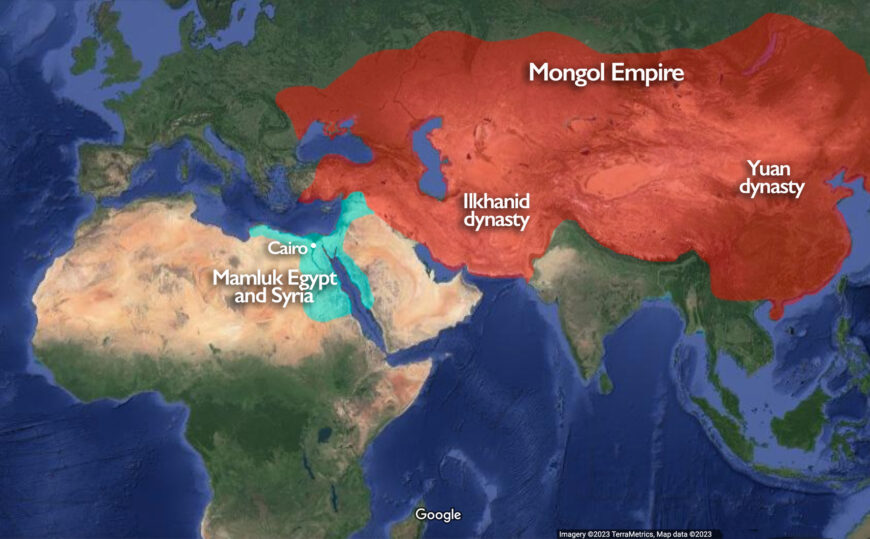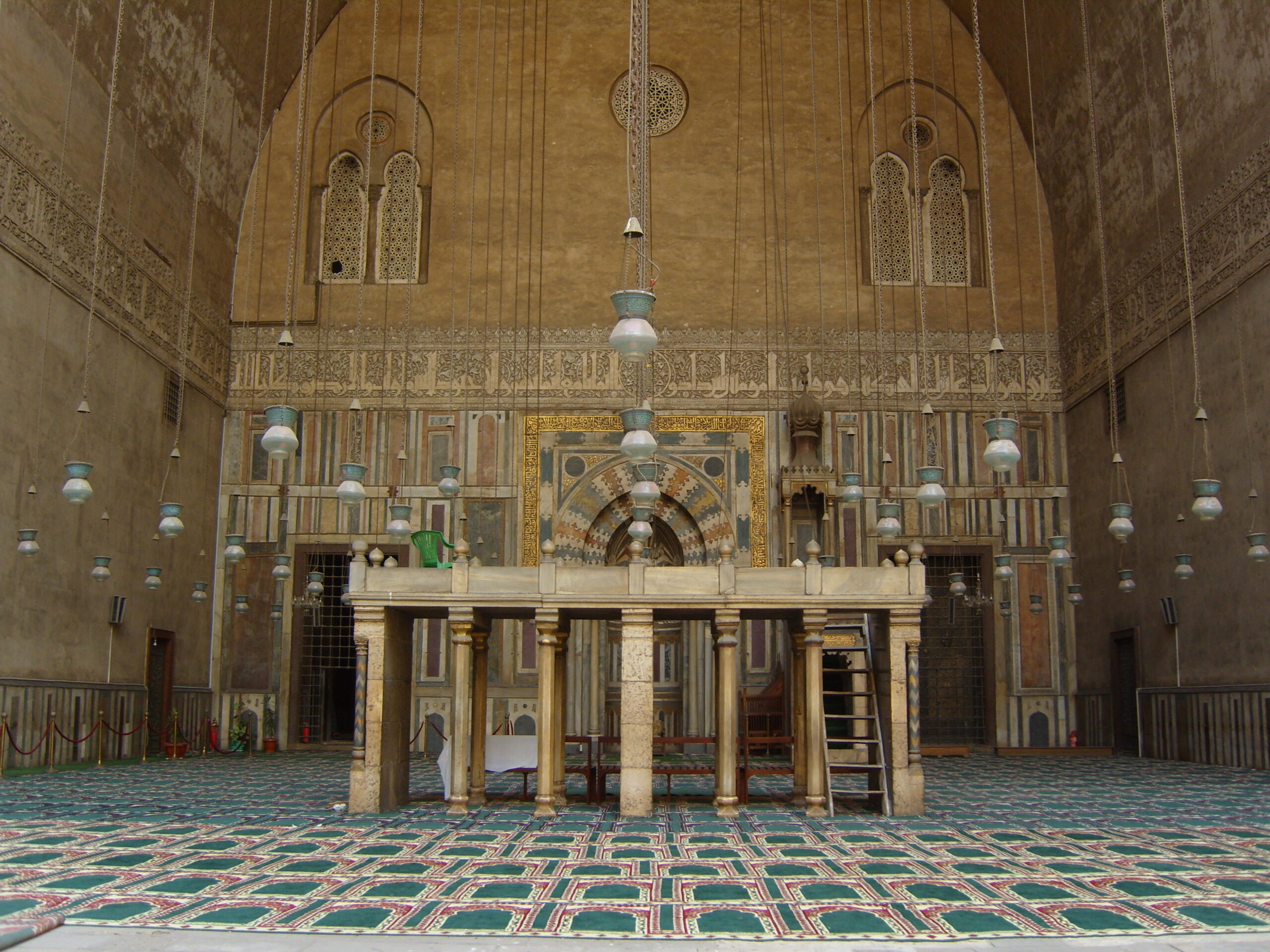
Dikka in a the qibla iwan, madrasa and Friday Mosque of Sultan Hasan, 1356–1363/758–764 AH, Cairo, Egypt (photo: Effeietsanders, CC BY-SA 3.0)
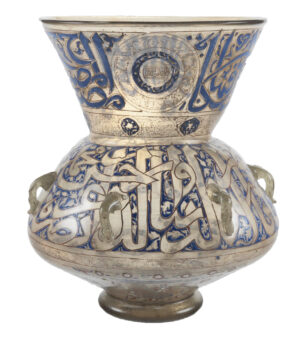
Glass lamp for mosque of sultan Hassan, Egypt, 1354–61, enameled and gilt glass, 35 cm high (Calouste Gulbenkian Museum)
Contemporary visitors to the mosque of the Mamluk sultan Hassan in Cairo, Egypt, get a glimpse of the complex’s original illumination. Its interior space is filled with light shimmering through hanging glass lamps, chandeliers, and metal candlesticks. These modern lamps hang from the ceiling in uniform rows, hinting at the mosque’s original lighting.
Fortunately, more than fifty of the mosque’s original glass lamps survive, including a large and impressive lamp now housed in the collection of the Calouste Gulbenkian Museum in Lisbon. Representing the highest caliber of glass and enamel production in Mamluk Egypt, the Gulbenkian lamp and the hundreds of other glass lamps that adorned sultan Hassan’s mosque would have shone brilliantly to illuminate God’s divine light and the sultan’s supreme authority.
Most often described as “mosque lamps,” because they commonly adorned mosques, glass lamps were actually used as lighting devices in a range of spaces, including mausoleums, madrasas, as well as in palaces and other prestigious buildings. These lamps would have originally contained a smaller glass vessel—usually a saucer or tube—which held oil and a wick.
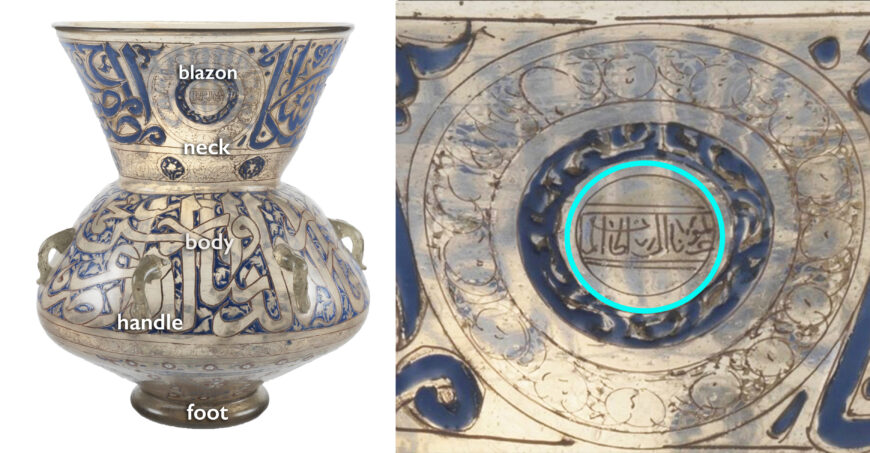
Glass lamp and detail of blazon, mosque of sultan Hassan, Egypt, 1354–61, enameled and gilt glass, 35 cm high (Calouste Gulbenkian Museum)
The Gulbenkian lamp has a flaring neck and a wide globular body with six glass handles, from which it would have been suspended from the ceiling with metal chains. Colored enamel (made with powdered colored glass), in red, blue, green, white, and gold adorns the surface of the vessel. Along its neck and body are Arabic inscriptions, including verses from the Qur’an and the name and titles of the sultan.
Intersecting the inscription on its neck are three medallions bearing the blazon (symbol) of sultan Hassan—a round shield divided into three registers with the phrase “glory to our lord the sultan.” Decorative motifs, such as arabesques and floral motifs, fill every available surface. In the size and complexity of their decoration, sultan Hassan’s mosque lamps were among the most ambitious glass vessels produced under the Mamluks.
Challenges of manufacture
Islamic enameled and gilded glass was the most prized form of Islamic glassware, and it was produced almost exclusively in 13th- and 14th-century Ayyubid and Mamluk Egypt and Syria. Glassmakers combined glass-blowing techniques that had been used since Roman times with new technical achievements in enamelwork and gilding.
The glassmaker first gathered molten glass on a blowpipe, blowing it to size and forming it to achieve the desired shape. While the glass was still malleable, it was transferred to a pontil, or iron rod, so that additional elements, such as the foot—here a circular disc—and handles could be added. The decorator added inscriptions and designs by mixing gold and enamel—here red, blue, white, and green powdered glass—with a binder, such as gum arabic, and applied it to the vessel with a brush or reed pen.
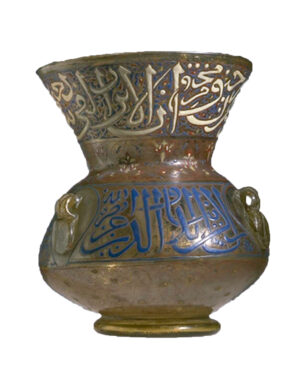
Glass lamp of sultan Baybars al-Jashankir, Egypt, 1309–10, enameled and gilded glass, 29 cm high (Victoria & Albert Museum)
The challenge came in the firing process. In order for the gold and enamel to melt and fuse to the glass surface, they needed to be heated (fired) at high temperatures. Medieval enamels had the same or a higher melting point than glass, which meant that the enamel workers risked deforming the lamp itself in the firing process. To make matters even more complicated, each color had different chemical properties, requiring different firing temperatures. Mamluk enamel workers mastered a technique that allowed them to fire all the enamels at the same time. The process required great skill and experience. If the vessel was removed too early, some enamels would not adhere to the surface, or would appear gray in color or bubbly in texture. On the other hand, if left in the furnace too long, some enamels could become overcooked, or spattered, and the vessel itself might become misshapen, as in a glass lamp for sultan Baybars al-Jashankir which leans heavily to one side. The larger the vessel and the more complex its shape and enamel decoration, the greater the risk of damage.
Measuring 35 cm in height, this lamp is on the smaller side for the sultan’s commissions, many of which ranged from 38–42 cm. However, it still exceeded earlier glass lamps, most measuring a mere 24–29 cm. The extensive enamel and range of colors on all areas of the lamp—interior and exterior—speaks not only to the considerable skill and dexterity achieved by the glassworkers, but also to sultan Hassan’s status in commissioning such an object.

Inscriptions on the body (left) and neck (right) of the mosque lamp, glass lamp for mosque of sultan Hassan, Egypt, 1354–61, enameled and gilt glass, 35 cm high (Calouste Gulbenkian Museum; photos: Richard Mortel, CC BY-NC-SA 2.0)
God’s divine light
The decoration of the lamp follows a model commonly found on other Islamic lighting vessels. The inscription listing the titles and name of the sultan is produced on a blue enamel background applied to the interior. The name and titles are left unadorned, revealing the transparent glass. Around the neck of the lamp, the craftsman inverted the color-scheme. The background and blazons of the sultan were left clear, while the letters of the so-called “light verse” (Ayat al-nur) from the Qur’an were executed in a deep blue enamel:
Allah is the light of the heavens and the earth,
the likeness of his light is as a wick-holder
wherein is a light,
the light in a glass
the glass as if it were a glittering star.Ayat al-nur (Qur’an 24:35)
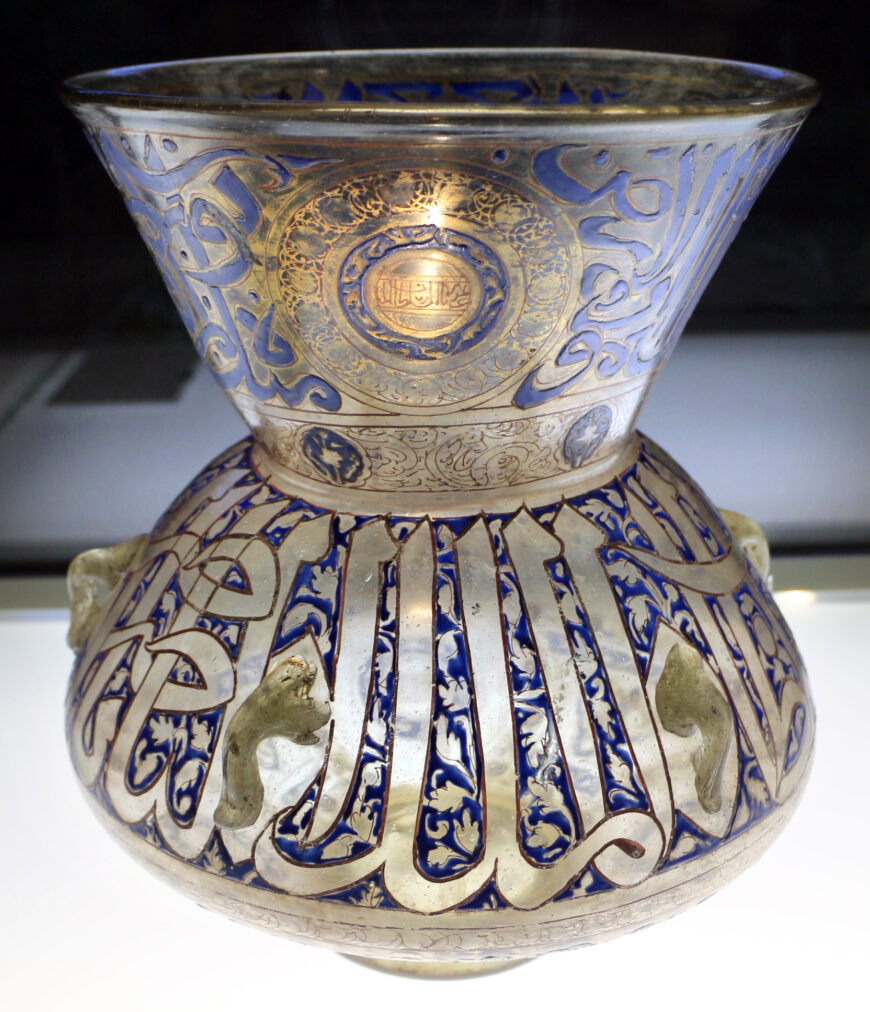
Light shining through blazon, glass lamp for mosque of sultan Hassan, Egypt, 1354–61, enameled and gilt glass, 35 cm high (Calouste Gulbenkian Museum; photo: Sailko, CC BY 3.0)
The verse, often found on mosque lamps, is particularly appropriate, as it describes God’s light through the metaphor of a wick floating in a dish of oil inside a glass object. When lit, the entire lamp would have glowed, evoking Allah’s divine light described in the verse. Sultan Hassan’s name, titles, and blazon would have been especially brilliant with light filtering through their transparent glass areas, emphasizing not only God’s divine light, but also the sultan’s divine right to rule.
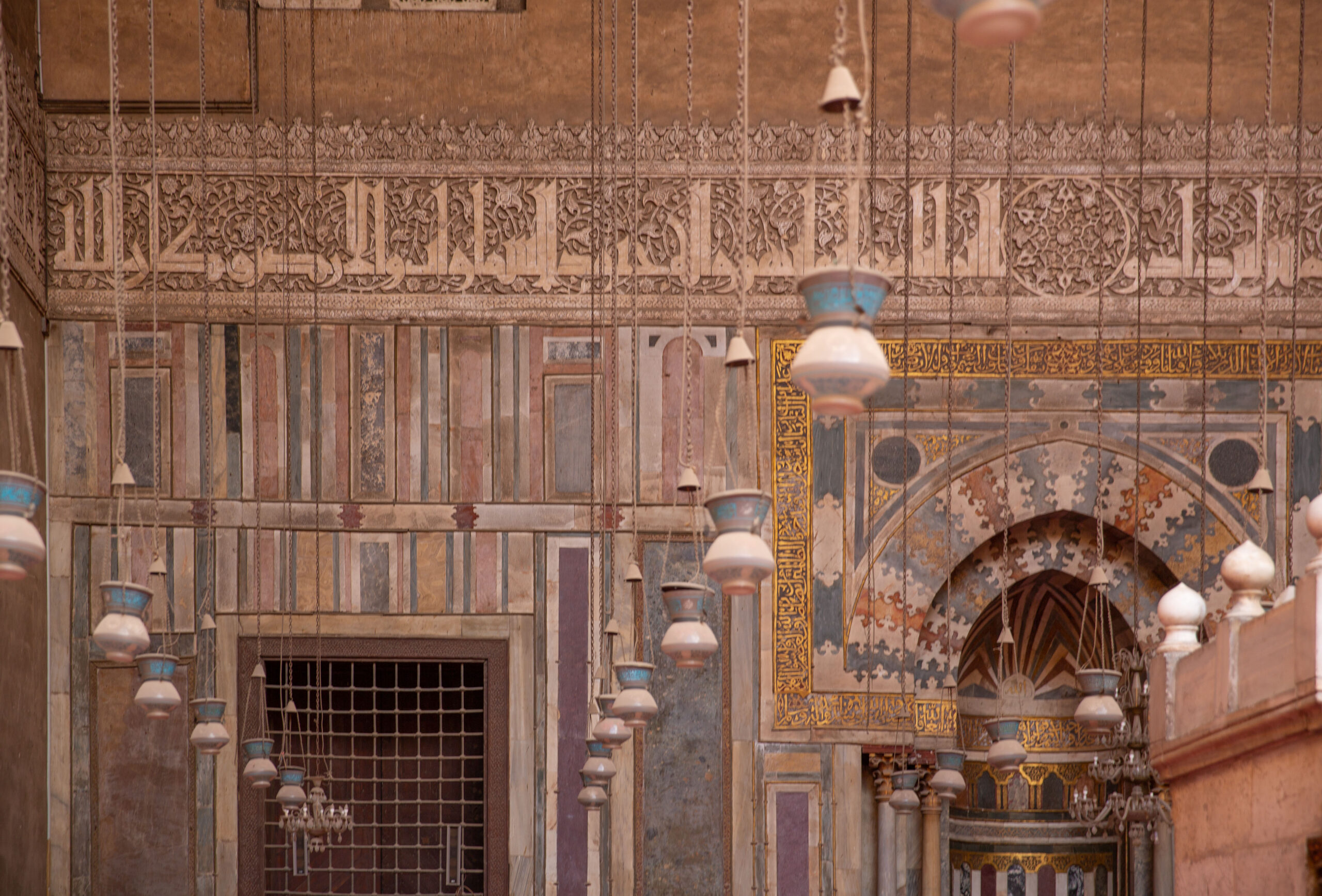
Modern glass lamps hanging in the sultan Hassan mosque, 14th century, Egypt (photo: Ariel Fein, CC BY-NC-SA 2.0)
Illuminating the sultan Hassan mosque and madrasa
Sultan Hassan’s complex consisted of a Friday Mosque, a madrasa, and a qubba, or mausoleum. The complex was composed of a central courtyard (sahn) with four iwans—halls enclosed on three sides and open to the courtyard on the fourth. The nearly fifty extant mosque lamps from the Hassan mosque represent the largest number of surviving Mamluk lamps from an individual patron or monument, and therefore allow us an unparalleled glimpse at its lighting system. While we don’t know where this particular lamp would have originally hung, based on 15th-century descriptions and a 19th-century rendering of the mosque interior by orientalist painter David Roberts, it is likely that it, and the other lamps, were evenly spaced across the interior of the iwans to illuminate the space in a unified fashion. This approach can still be seen today in the modern lighting of the mosque, where glass lamps are hung at repeated intervals.
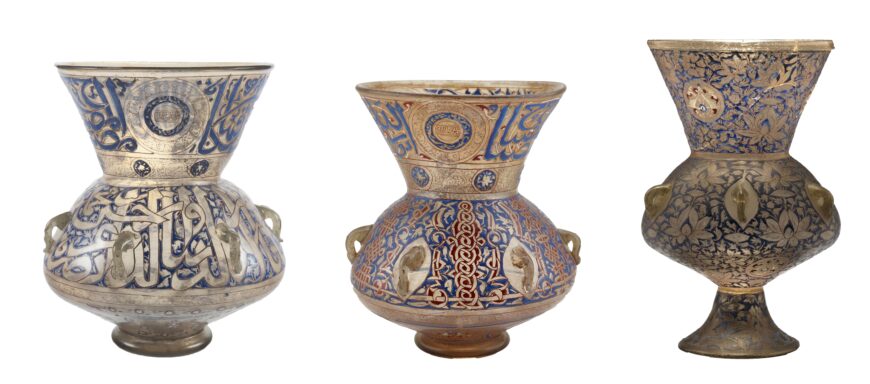
Left: type 1, Glass lamp for mosque of sultan Hassan, Egypt, 1354–61, enameled and gilt glass, 35 cm high (Calouste Gulbenkian Museum); center: type 2, Glass lamp for mosque of sultan Hassan, Egypt, 1354–61, enameled and gilt glass, 33.6 cm high (Freer Museum); type 3, Glass lamp for mosque of sultan Hassan, Egypt, 1354–61, enameled and gilt glass, 38.5 cm high (© Trustees of the British Museum)
Although uniformly hung, the original lamps bore three different types of decoration. Many of the lamps followed the decoration of the lamp we have been discussing, while the remaining ones adopted two other approaches. A second type featured the light verse inscribed in ornate Arabic calligraphy along its neck, while the titles on its body were replaced by diverse designs, including lotus flowers, palmettes, and interlaced motifs imitating plaited Kufic, an Arabic script in which the vertical strokes of the Arabic letters are knotted together to form intricate patterns. The third group of lamps abandoned inscriptions entirely, instead featuring only arabesque patterns and lotus flowers. Across these three types of lamps, there was still further variation, with artisans experimenting with new patterns and techniques, including a wider color palette and colors layered one over the other, which were even more challenging to achieve during the firing process.
Despite the variety across the decoration of the mosque lamps, overall they presented a cohesive design that paired well with the decoration of the building itself. Lotus flowers, for example, appear frequently on the glass lamps and in other media, including metalwork, as in a candlestick base produced for sultan Hassan’s father. These motifs, which can also be found along the door frame of sultan Hassan’s mosque, represent a new interest in Chinese forms in 14th-century Mamluk art.
Beginning in the 13th century, the invasions of the Mongols across West Asia brought devastation, but also allowed for increased trade and cultural exchange with East Asia. One branch of the Mongol dynasty, known as the Ilkhanids, centered its power in northwest Iran. The Ilkhanids maintained ties with the ruling Mongol dynasty in China (the Yuan dynasty), allowing for the exchange of motifs, such as the lotus flower. It was prominently incorporated into Ilkhanid art—in manuscript illumination, ceramics, and textiles—where it connoted attributes of kingship and nobility. With increased contact between the Mamluk and Ilkhanid courts, especially through trade and marriage, the lotus flower, and other motifs, came to feature prominently in Mamluk art.
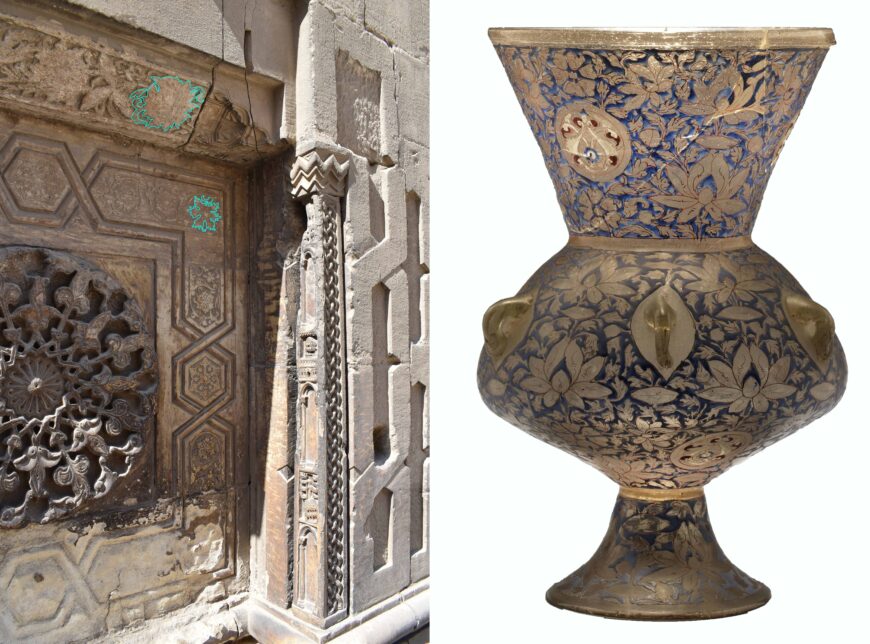
Left: lotus flower carvings, portal, sultan Hassan mosque, 1356–63, Egypt (photo: Hatem Moushir, CC BY-SA 4.0); right: glass lamp for mosque of sultan Hassan, Egypt, 1354–61, enameled and gilt glass, 38.5 cm high (© Trustees of the British Museum)
On the façade of the Hassan Mosque, an angled molding features large carved lotus blossoms, while below, in alternating long and short hexagonal frames, we find rich floral decoration, including lotus, peony, and chrysanthemum flowers, which surely would have resonated with the enamel floral motifs adorning the mosque’s lamps. Combined together, the glass mosque lamps which originally illuminated the interior of sultan Hassan’s mosque would have cast shimmering light and rich ornament throughout his madrasa-mosque-tomb complex.
Unfortunately, sultan Hassan did not survive to see his mosque to completion, and therefore never witnessed its remarkable illumination. As lamps were typically commissioned towards the end of the construction project, due to their fragility, many of the lamps themselves were also completed after his death. However, in the scale of the commission, the diverse ornament, and technical virtuosity, the glass lamps of sultan Hassan’s mosque portrayed him as a devout and powerful ruler long after his death.
Additional resources
Julie Bonnéric, “Social and Cultural Interpretation of Material Culture: The Example of Lighting Devices in Mamluk Mosques,” in Living with Nature and Things: Contributions to a New Social History of the Middle Islamic Periods (Bonn: Bonn University Press, 2020), pp. 453–74.
Stefano Carboni, “Fifteenth-century Enameled and Gilded Glass made for the Mamluks: the End of an Era, the Beginning of a New One,” Orient 39 (2004): pp. 69–78.
“Enameled and gilded glass from Islamic Lands,” Heilbrunn Timeline of Art History.
“Glass from Islamic lands,” Heilbrunn Timeline of Art History.
Listen to a recording of the “light verse, “Mosque lamp of Amir Qawsun,” Heilbrunn Timeline of Art History (click on “LISTEN to experts illuminate this artwork’s story”).
Rachel Ward, “Mosque Lamps and Enamelled Glass: Getting the Dates Right,” in The Arts of the Mamluks in Egypt and Syria: Evolution and Impact, edited by Doris Behrens-Abouseif (Bonn: Bonn University Press, 2012), pp. 55–76.
Rachel Ward, “The Origins of the Gilded and Enamelled Glass Industry in Syria,” Transactions of the Oriental Ceramic Society 75 (2011): pp. 39–52.

